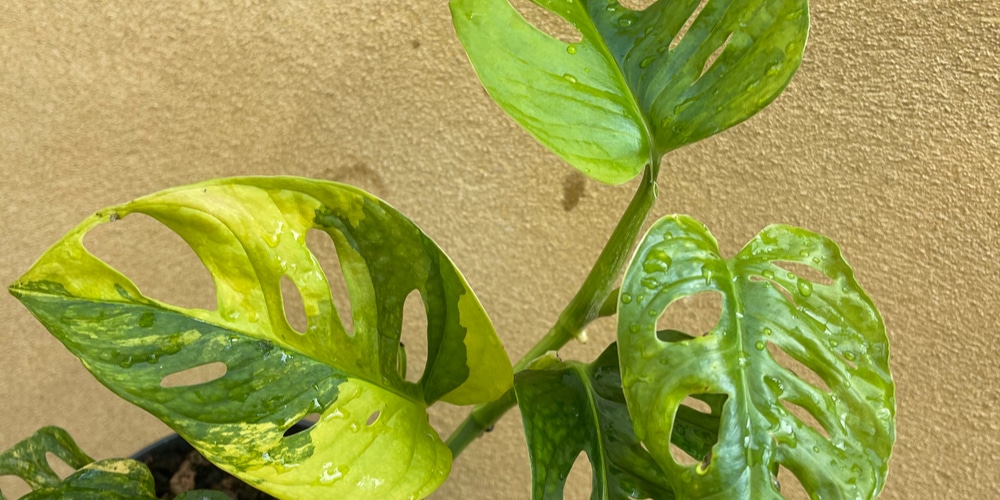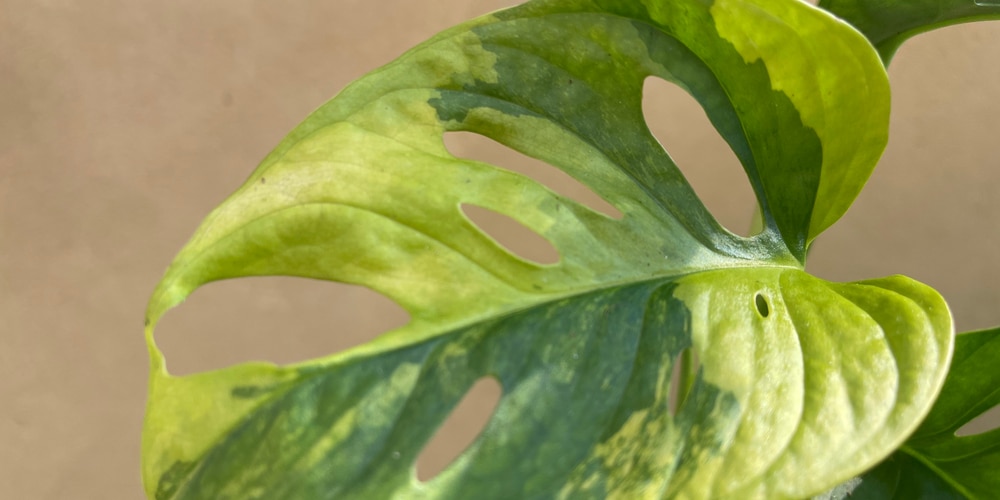The Monstera Aurea, also known as Variegated Monstera, is a fast-growing houseplant with stunning foliage native to the forests of Southern Mexico and Panama. Compared to other similar plants, this species is more expensive.
The higher prices have to do with the unique white or yellow variegations that give these plants their names. Plus, the demand for Monstera Aurea is high (and for reasons, these plants are beautiful!), but the supply is low, which causes the price to rise.
To learn more about these rare tropical plants, keep reading. Here, we included everything you need to know about them.
| Botanical Name | Monstera Deliciosa Thai Constellation |
| Common Name | Monstera Aurea or Monstera Variegata |
| Plant Type | Perennial |
| Native Area | Central America |
| Size When Mature | 12- 18 feet |
| Bloom Time | This plant doesn’t produce blooms |
| Sun Requirements | Bright Indirect Light or Partial Sun |
| USDA Hardiness Zones | 9 – 12 |
| Soil PH Range | 5.0-7.5 |
| Soil Type | Rich, well-draining, loose. |
| Water Needs | Medium (once per week) |
What you Need to Know About Monstera Aurea
Monstera Aurea is one of the five species from the Monstera Deliciosa family. These plants are all rare and expensive. However, the Monstera Aura is the most widely available type in the United States.
The foliage of these plants is unique: the leaves are uniquely variegated in shades of creamy white and yellow. While not particularly challenging to grow, you must fulfill their basic requirements to have them in your house.
The good news is that under the proper conditions, these plants will thrive. They have no problems making any corner of your home look lush and attractive. Don’t wait for blooms: these plants do not produce flowers.
If you have pets or curious kids around, you may have to consider getting another plant (or monitor it closely): Monstera Aurea is toxic to humans and most pets when ingested.
How to Care for Monstera Aurea
Caring for Monstera Aurea is not challenging. But, to have thriving plants like those you see in home design magazines, recreating the optimal conditions for their growth in your house is crucial.
Look no further for tips about growing Monstera plants. Here’s everything you need to know about growing and caring for a thriving Monstera Aurea.
Light
Monstera Aurea needs the bright indirect sun for most of the day to produce the lush foliage we all love about it. Be careful not to expose this plant to too much sun. Sunlight will damage your leaves and might cause them to lose their attractive variegation patterns.
Of course, with that, we are not saying that you should place them somewhere dark. All plants need light for photosynthesis: too little of it will halt their growth.
For best results, place your plant next to an east-facing window, where it can get enough sunlight that is not too strong.
If you only have space in brighter corners of your house, keep your Monstera Aurea a few feet away from the window and consider getting sheer curtains to protect your plant from sunburn.
Water and Soil Needs
These tropical plants love moisture. Plant them in well-draining, loose soils with adequate aeration. A mixture of peat moss, orchid bark, and perlite will ensure excellent results.
While Monsteras are not too fussy about pH, if you can, levels between 5.0 to 7.5 are optimal. Don’t forget to add some mulch around your plant to increase the nutrient content and improve water retention.
One of the most challenging things about this plant is getting watering right. Leaving the soil soggy will cause roots to rot.
For this reason, you should always ensure the top one to two inches are dry before adding more water: feel the soil with your fingers to avoid overdoing it.
Temperature Requirements
While you can plant Monstera Aurea anywhere indoors, provided that you ensure adequate protection from low temperatures, you will only be successful planting it outdoors in hardiness zones between 9 and 11.
Indeed, these plants will not survive temperatures below 55°F. Forget about having them live through hard frosts. Instead, the ideal temperature for their growth is between 65 and 80°F.
Because of their natural habitat, Monstera Aureas need humidity. To keep conditions optimal, consider getting a humidifier. Alternatively, mist the leaves regularly with water.
You can also get a pebble tray to increase water retention. In general, 65% humidity would be ideal. Other conditions might cause your plant to dry or produce brown and crispy leaves.
Fertilizer
Fertilizing these plants depends on which part of the world you live in: if your region is tropical and the weather is warm all year round, you can feed your plant every month to ensure it grows healthy and thriving.
In other parts of the world, where winter temperatures fall, the growing season is shorter: only feed your plants once a month between spring and summer.
Select a balanced all-purpose fertilizer to keep things simple. As with everything in life, too much of a good thing can be damaging.
Do not overfeed your plants: always follow the instruction you find on the labels. Never use more than intended to avoid creating problems for your plant.
Common Diseases
Some of the most common issues with these plants involve inadequate watering. If you notice brown or yellow leaves and tips, you might be giving your plant too little or too much watering. Adjust your watering schedule accordingly.
Plus, spider mites and mealybugs are about the only pests that will attack your Monstera Aurea. As soon as you notice something off with your plant, take immediate action. You’ll want to avoid infestations at all costs.
Monstera Aurea Propagation
Ok, so you finally purchased (and found) the Monstera Aurea of your dreams. You are thinking about adding more to your house: they look good! However, these plants are expensive.
But we have good news for you: you can propagate them from cuttings with little effort.
Once established, you can cut new growth and place them in soil or water to propagate your Monstera. Both methods have high chances of success (and they are simple to carry out).
Take a four to six-inches long stem cutting with at least one node and a few leaves. Plant it in well-draining soil after dipping it in rooting hormone for best results. Ensure you keep the soil moist but not soggy.
Place your cuttings in a location that receives indirect sun for most of the day: wait for about four to six weeks, and your plant will start to root. At that point, your cuttings will be ready to move to a different container.
Alternatively, place the cuttings in a glass container with water and a drop of rooting hormone. Plant them in the soil once you see roots getting between two to four inches long. Don’t forget to frequently change water to minimize the spread of diseases and fungal infections.
Related Article: 11 of The Most Expensive Plants in the World


